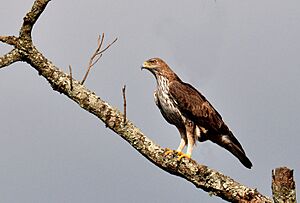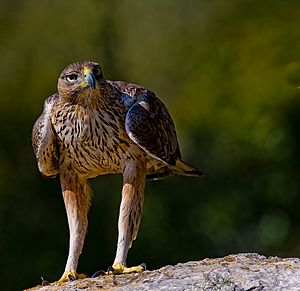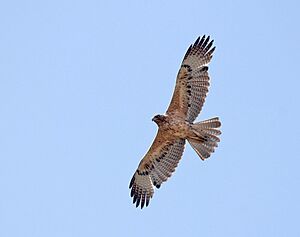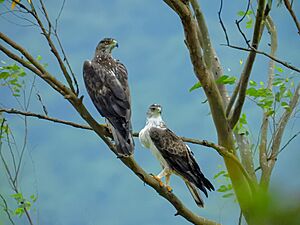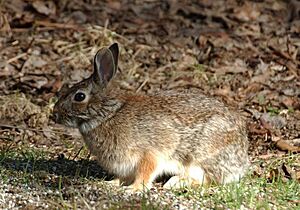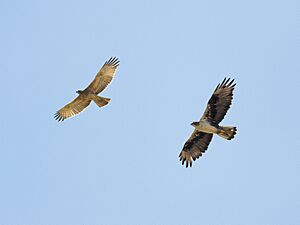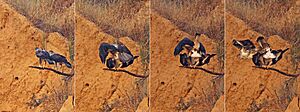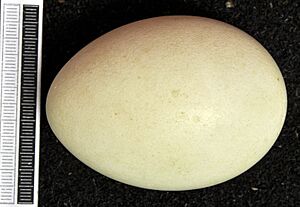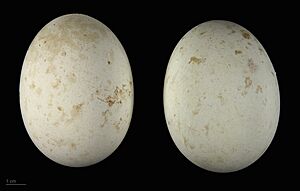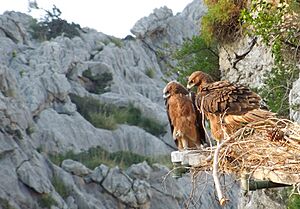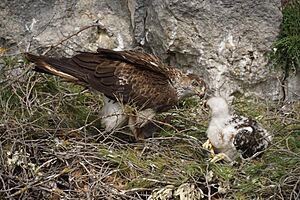Bonelli's eagle facts for kids
Quick facts for kids Bonelli's eagle |
|
|---|---|
 |
|
| An adult Bonelli's eagle perched in Spain | |
| Conservation status | |
| Scientific classification | |
| Genus: |
Aquila
|
| Species: |
fasciata
|
| Subspecies | |
|
|
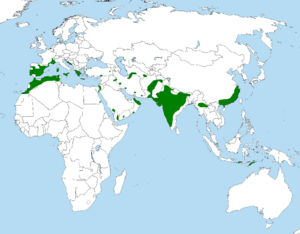 |
|
| Distribution of A. fasciata | |
| Synonyms | |
|
|
The Bonelli's eagle (Aquila fasciata) is a large bird of prey. It is named after Franco Andrea Bonelli, an Italian scientist who first found a specimen. This eagle is part of the Accipitridae family, which includes all eagles. It has feathered legs, making it a "booted eagle."
Bonelli's eagles live in Southern Europe, parts of Africa, and across Asia to Indonesia. They are usually found in hilly or mountainous areas with rocky cliffs. These eagles are skilled hunters. They mostly eat birds and mammals, especially rabbits, gamebirds, and pigeons.
Even though they live in many places and are listed as a least concern species by the IUCN, their numbers are dropping. This is happening in many areas, especially in Europe. The main reasons for their decline are habitat destruction, electrocution from power lines, and people hunting them.
Contents
About Bonelli's Eagles
What is a Bonelli's Eagle?
The Bonelli's eagle was first described in 1822 by a French scientist. It belongs to a group of eagles called "booted eagles." These eagles all have feathered legs. For a long time, the Bonelli's eagle was thought to be very similar to the African hawk-eagle. However, scientists now know they are different species.
Recent DNA studies have shown that Bonelli's eagles are actually closely related to the golden eagle. This group also includes other large eagles like Verreaux's eagle and wedge-tailed eagle. There are two types, or subspecies, of Bonelli's eagle. One lives across Europe and Asia. The other, called A. f. renschi, lives on the Lesser Sunda Islands. This second type is a bit smaller and has more stripes on its feathers.
How Big Are They?
Bonelli's eagles are medium-sized eagles. Like most birds of prey, the female is larger than the male. Females can be about 10% bigger. These eagles are usually 55 to 74 cm (22 to 29 in) (about 22 to 29 inches) long. Their wingspan can range from 143 to 180 cm (56 to 71 in) (about 4.7 to 5.9 feet).
Males typically weigh around 1.94 kg (4.3 lb) (about 4.3 pounds). Females are heavier, averaging 2.62 kg (5.8 lb) (about 5.8 pounds). Bonelli's eagles have a strong body and long, feathered legs. They often sit upright on rocks, trees, or posts. Their feet and talons are very large and powerful for their size. The talon on their back toe is especially long.
What Do They Look Like?
Adult Bonelli's eagles are dark brown on their backs. They have pale edges on most feathers. They also have a white patch on their upper back. Their tail is grey with thin dark bars and a wide black band near the tip. The tip of the tail is white. Their head is dark brown, and their throat is white. Their underside is creamy white with dark brown streaks. Female adults tend to be darker and have more patterns than males.
Young eagles (juveniles) are lighter brown. They have a rusty-brown head. Their tail has clearer bars than adults. The underside of young eagles is light reddish-brown with very few dark streaks. Their eyes are hazel-brown. Adults have yellow or orange eyes. The beak and feet are always pale yellow.
When flying, Bonelli's eagles have a large head and broad, long wings. They fly with powerful, shallow wing beats. When they glide, their wings are often flat. They often fly in pairs. Adults have a white patch on their back. Their white underwing feathers contrast with a dark band across the middle of the wing. Young eagles are brown above with darker wingtips. Their underwings are light reddish-brown. They have a small white area on their primary feathers.
It's usually easy to tell a Bonelli's eagle apart from other birds. However, sometimes they can be confused with other raptors. For example, honey buzzards can look similar, but they are usually slimmer. Northern goshawks are smaller with shorter wings. Short-toed eagles are about the same size but have different wing shapes and patterns.
What Sounds Do They Make?
Bonelli's eagles are usually quiet, except during breeding season. Their main call is a loud, shrill scream. It sounds like yuiii-yuiii-gii-gii or heeeeii-heeeeii. Both males and females make this call. Females often call loudly when the male brings food to the nest. Other sounds they make include a low klu-klu-klu and a repeated ki ki ki when alarmed.
Where They Live and Their Home
Where Do Bonelli's Eagles Live?

Bonelli's eagles live in many scattered places around the world. In northwestern Africa, they are found in Morocco, Algeria, and Tunisia. Some also spend winters along the coast of west Africa.
In southern Europe, they live in parts of Portugal, Spain, and southern France. They are also found on the Italian islands of Sardinia and Sicily. In southeastern Europe, they live in Croatia, Macedonia, and Greece.
Outside of Europe, they are found in Turkey, Cyprus, Israel, and other parts of the Arabian Peninsula. Their range extends into Iraq, Iran, and Turkmenistan. Further east, they live in Afghanistan, Pakistan, and most of India. They are also found in Myanmar, Thailand, Laos, and southern China. An isolated group lives on the Lesser Sunda Islands in Indonesia.
Young Bonelli's eagles can travel hundreds of kilometers from their nests. They have been seen in places far from their usual homes, like Germany and Kazakhstan.
What Kind of Places Do They Like?
Bonelli's eagles prefer dry, sunny places. They like rocky areas with many cliffs and steep canyons. They are very good at hunting in rough, rocky terrain. Their habitats often have low bushes or scattered trees. These areas are important because they hold prey.
They usually avoid very dense forests and big cities. However, they are starting to use farmland more, especially in Spain and Sicily. This is probably because they have to hunt more pigeons as rabbit numbers decline. In some parts of Asia, they can live in tropical rainforests, but they still prefer rocky areas within these forests.
Bonelli's eagles usually live at elevations below 1,500 m (4,900 ft) (about 4,900 feet) in Europe. In Africa, they can live up to 2,000 m (6,600 ft) (about 6,500 feet). In Asia, they can be found as high as 3,750 m (12,300 ft) (about 12,300 feet) in places like the Himalayas.
How They Live and What They Eat
Hunting and Eating Habits
Bonelli's eagles spend a lot of time flying and circling over their territory. They are powerful predators and are known for being "bold." Their main hunting style is similar to a goshawk. They often sit on a hidden perch or a high rock. From there, they watch for prey. When they spot an animal, they quickly dash out to catch it. They might chase birds as they fly away or mammals running for cover. Sometimes, they even walk on the ground to get their prey.
These eagles also hunt by flying low over the ground, like a harrier. They can catch birds from the ground, bushes, or even in mid-flight. Sometimes, two eagles will hunt together. One eagle might scare a flock of birds, and the other will quickly catch one. However, studies show that hunting in pairs doesn't always lead to more or bigger prey. It might be more important for the pair's bond.
Bonelli's eagles mostly hunt live prey. They rarely eat dead animals (carrion) or steal food from other raptors. However, they will take injured prey. They also readily hunt young animals.
Bonelli's eagles eat a wide variety of animals, almost 200 different species. They mainly hunt birds and mammals. They eat reptiles less often. In Europe, they are known for hunting rabbits and partridges. They also eat pigeons, gulls, and corvids.
The average size of prey they catch is about 416 g (14.7 oz) for males and 459 g (1.012 lb) for females. This means their prey is usually about 20-45% of their own body weight. They are successful in about 28.5% of their hunts.
Rabbits and Other Small Mammals
The European rabbit is the most important prey for Bonelli's eagles in Europe. In some areas of Spain, rabbits make up over 22% of their diet. Young rabbits are often caught because they are forced into open areas by older rabbits. Rabbits are hunted more often in summer when young rabbits are moving around. Most rabbits caught weigh between 500 and 1,500 g (1.1 and 3.3 lb).
Rabbit populations have dropped a lot in Europe due to diseases. Even so, Bonelli's eagles still try to hunt them. They also hunt other small mammals like Granada hares and Indian hares.
Gamebirds and Pigeons
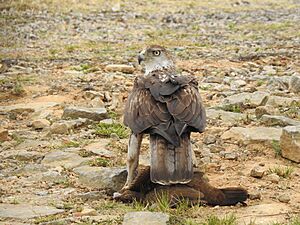
The red-legged partridge is another important prey for Bonelli's eagles. These birds live in the same areas as rabbits. In Cyprus, the chukar is their main prey. In Asia, they eat many different gamebirds, including Indian peafowl (though usually young ones). In the Lesser Sunda Islands, they often hunt green junglefowl and village chickens.
Pigeons are also a very important food source. They often hunt rock doves (feral or domestic) and common wood pigeons. In some areas, like Portugal, pigeons have become their main food because rabbit numbers are low.
Other Birds They Hunt

Bonelli's eagles also hunt many other medium-sized birds. They often eat yellow-legged gulls. They also hunt a variety of water birds, from small common sandpipers to large painted storks.
Corvids, like Eurasian magpies, western jackdaws, and carrion crows, are also commonly hunted. They can even catch large common ravens. Other birds they eat include cuckoos, swifts, bustards, bee-eaters, woodpeckers, and parrots. Small songbirds are eaten less often. Overall, birds make up the largest part of their diet.
Other Animals They Eat
Besides rabbits, other mammals are not as common in their diet. However, some rodents can be important. They hunt red squirrels and black rats. In Africa, they eat fat sand rats. They also hunt other squirrels, mice, and voles.
Sometimes, they attack larger mammals, usually young ones. This includes young blackbucks, chinkaras, domestic goats, and domestic sheep. They have also been known to attack young red foxes, wildcats, and stone martens. In India, they have caught adult Bengal foxes.
Reptiles are usually a smaller part of their diet. They prefer hunting lizards over snakes. In Cyprus, they eat starred agamas. In Spain, they hunt ocellated lizards. In India, they eat monitor lizards. They might also eat small numbers of toads and insects.
Who Are Their Competitors?
Bonelli's eagles often share their habitat with other large birds of prey. Their biggest competitor in Europe and the Middle East is the golden eagle. Both eagles like rocky areas. Golden eagles usually live at higher elevations, but they can also live in lower areas.
In Spain, these two eagles compete for territory and food. However, Bonelli's eagles eat more birds, while golden eagles hunt more rabbits. Golden eagles are larger and can sometimes scare away young Bonelli's eagles. This makes it harder for Bonelli's eagles to expand their territory.
Other birds that share cliff habitats with Bonelli's eagles include peregrine falcons, common ravens, and Eurasian eagle-owls. Larger birds like griffon vultures can sometimes take over Bonelli's eagle nests.
Bonelli's eagles are considered "super predators" in Europe because they hunt other predators. They have been known to hunt other birds of prey like European honey buzzards, red kites, northern goshawks, and various falcons and owls. They have even been seen hunting an adult Eurasian eagle-owl.
However, Bonelli's eagles can also be prey for other animals. Eurasian eagle-owls have been known to eat Bonelli's eagle nestlings. Golden eagles have also been seen preying on adult Bonelli's eagles. Stone martens sometimes steal their eggs.
Family Life and Raising Young
Pairing Up and Nests
Bonelli's eagles usually stay with the same mate for life. They defend their territory with aerial displays. They fly in circles, call loudly, and perform "sky-dances." During a sky-dance, one eagle dives from a great height with its wings almost closed, then rises again. This can be repeated many times.
Their breeding season is from late January to July in Europe. In India, it's from November to September. Both eagles spend a few months near the nest before breeding.
Their nests are very large, made of branches and sticks. They can be up to 1.8 m (5 ft 11 in) (about 6 feet) wide and 60 cm (24 in) (about 2 feet) deep. Some nests used for many years can be even bigger. Nests are often built high on cliff ledges or in large trees. Very rarely, they might nest on buildings.
Historically, Bonelli's eagles in Europe mostly nested on cliffs. However, in Portugal, many now nest in trees, especially in eucalyptus trees. In India, they switch between tree and cliff nests. They might even nest close to people if there isn't too much disturbance. Eagles often use the same nest year after year, or they might have a few alternate nests. Building a new nest takes about a month.
Growing Up
Bonelli's eagles usually lay two eggs, but sometimes only one. Rarely, they might lay three eggs. The eggs are mostly white with some brown spots. Incubation, when the parents sit on the eggs, lasts about 37 to 45 days. The female does most of the incubating, while the male brings food.
When the eaglets hatch, they are helpless. Their first feathers appear after 25–35 days. By 45 days, they are mostly covered in feathers and can feed themselves. They leave the nest (fledge) when they are 56 to 65 days old.
The female stays near the nest for the first two weeks after hatching. She attacks any potential predators, like other raptors or monkeys. However, unlike some other eagles, Bonelli's eagles rarely attack humans at the nest. The male also helps with brooding and feeding the young.
The young eagles stay with their parents for about 8 to 11 weeks after fledging. During this time, the parents continue to bring them food. The length of this period can depend on how good the habitat is and how skilled the parents are. Eventually, the young eagles leave their parents' care on their own.
Life After the Nest
After leaving the nest, young Bonelli's eagles travel far. In Europe, they disperse an average of 142 d (12,300 ks) after hatching. They can travel from 50 to 536 km (31 to 333 mi) (about 31 to 333 miles) from their birth nest. This long-distance travel helps mix the genes of different eagle populations.
Young eagles sometimes gather in shared roosting spots. In Spain, up to 11 young Bonelli's eagles have been found roosting together. They sometimes share these spots with young Spanish imperial eagles.
Breeding Success and Challenges
The number of young eagles that successfully fledge can vary a lot. In Europe, about 65.7% of breeding attempts are successful. Of these, most produce one or two fledglings. Very rarely, three young eagles fledge.
Sometimes, the older nestling will attack and even kill its younger sibling. This is called siblicide. It happens in about 20% of nests. This species is called a "facultative cainist" because the second chick can sometimes survive. Siblicide is more likely to happen when there is not enough food, when the nest is disturbed, or during bad weather.
Bonelli's eagles have been known to eat their own dead nestlings. Sometimes, people intervene to help the younger chicks survive. In India, the success of breeding depends on the habitat and how much prey is available. In protected areas, nests often produce two fledglings. In degraded areas, they often produce only one.
If eggs or young are stolen, the parents might lay new eggs. However, cold temperatures and heavy rains can reduce breeding success. In cooler areas, young eagles often fly south to warmer places.
Conservation Efforts
Bonelli's eagle populations have dropped sharply in many areas. In the 1990s, there were only about 2000-3000 pairs in Europe and North Africa. By the 2000s, Europe had only about 1500 pairs, a 30% reduction since the 1950s. This decline means the species is considered critically endangered in some local areas.
Local extinction is possible in many places. For example, Bonelli's eagle might be extinct as a nesting species in Bosnia and Herzegovina. In Spain, their numbers have dropped in many provinces. In Israel, their population has been cut in half. The lack of research in Asia makes it hard to know the full extent of their decline there.
Bonelli's eagles face many threats. In Europe and Cyprus, they are often hunted by hunters and pigeon-fanciers. Shooting and poisoning are still common. Their habitat is also being destroyed by roads, farming, and human activity. Even tourists can disturb them.
From 1990 to 1996 in Spain, 55% of dead Bonelli's eagles died from electrocution on power lines. Another 26% died from poisoning and shooting. Adults were mostly killed by people, while young eagles died from electrocution. Wind farms are also a growing threat. Lead poisoning from bullets in prey is another problem. Low genetic diversity in some populations is also a concern.
Helping Bonelli's Eagles
Research shows that protecting their habitats and increasing their survival rates are the most important ways to help Bonelli's eagles recover in Europe. Reducing the risk of electrocution from power lines and stopping persecution are key steps. Scientists found that fixing only 27% of dangerous power lines could reduce bird deaths by 99%.
Since 2015, biologists have been insulating dangerous power lines in Spain. This has helped local populations grow. However, other human-caused deaths, like car collisions, have increased. Spanish researchers also provide extra food to eagles, which can help them produce more young.



